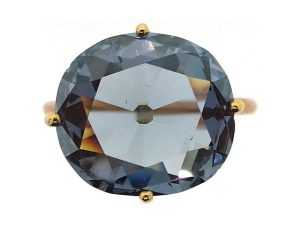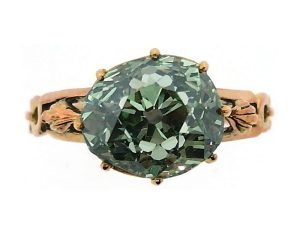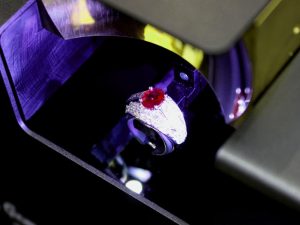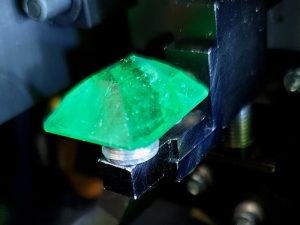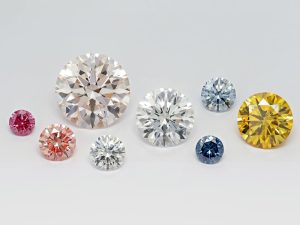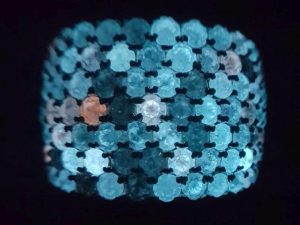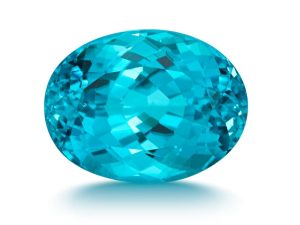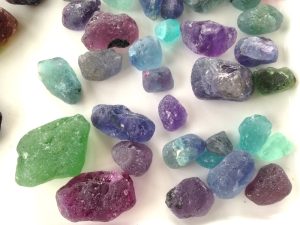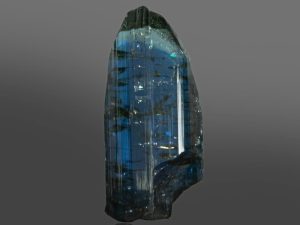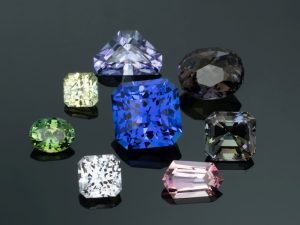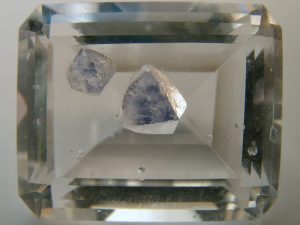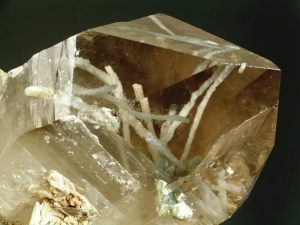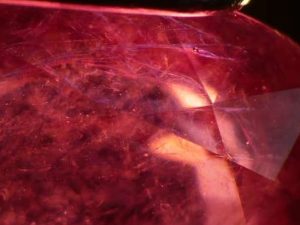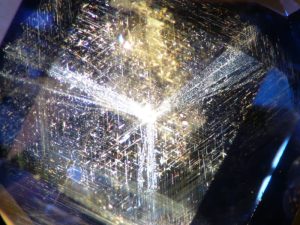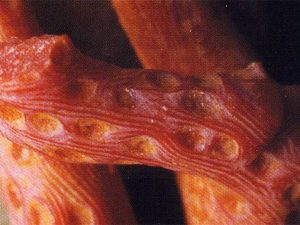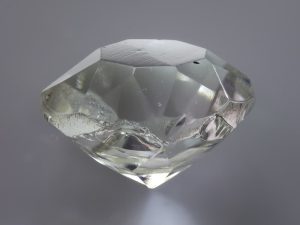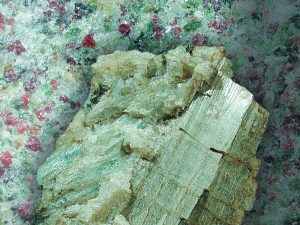Pre-Conference Vienna Tour
Historic diamond rings from the Natural History Museum Vienna – Appraising the invaluable?
The top five most highly valued gemstones ever sold at auction to date are fancy colour diamonds, due to their exclusivity. This makes diamond-grading reports relevant also to valuing historic items in museum collections, in particular to ascertain current values for insurance or exhibition purposes. Research started back in 2013 (Hainschwang et al.), using the historic green diamonds in the museum collection as untreated reference samples. Next, a selection of twenty rings set with natural blue, pink, green, brown, yellow and white diamonds were examined further. Most of the diamond rings were bought back in the 18th century, or before 1806 at the latest, from the famous ring-stone collection of Emperor Franz Stephan of Lorraine, founder of the museums collection.
Difficulties can occur when examining mounted diamonds as the 4Cs cannot be determined with 100% accuracy. FTIR, UV-Vis-NIR, fluorescence and photoluminescence spectra were recorded at room temperature.
Alberto Scarani, Mikko Åström (MAGILABS, USA, Finland)
Advanced Instruments for testing of Gems and Diamonds
Implementation of modern spectroscopy in Gemology. Raman/PL, FTIR, UV-Vis-NIR, and fluorescence, the most used techniques are explained along with their major applications in the daily work of the gemological laboratory. Identification of synthetics and treatments, detection of elements like Copper in Paraiba Tourmaline or iron in Emeralds or Magmatic sapphires. Detection of spinel treatment by photoluminescence. Impregnation identification by fluorescence spectroscopy and FTIR Diamond types, their nitrogen aggregates and lattice defects. These are only some of the critical issues which will be covered and solved with the aid of the most common spectroscopic techniques used nowadays in the Gemlab.
Branko Deljanin (CGL lab, Canada)
Historical Review of Detection Instruments for Diamonds of Different Origins
Is overview of use of screening and identification instruments in last 25 years when colorless Laboratory Grown Diamonds (LGD) were rare, up to now, with industry-wide shift towards laboratory-grown diamonds.
While well-equipped labs can identify LGDs and issue a report accordingly, the science of diamond no longer resides in the lab, as diamond dealers, gemmologists, appraisers, and retailers need help to at least screen and identify natural and laboratory-grown diamonds. Recently, a growing number of detection tools have been developed using several different screening or detection methods. There are over 70 instruments on the market, so diamond trade is confused on proper use and interpretation of results.
It is strongly recommended to test each diamond in question with minimum 3 instruments, as there is no single instrument from any of 4 groups (standard, UV transparency, luminescence and advanced) that could give all the time 100% ID of diamond in question.
Dr. Claudio C. Milisenda (DSEF German Gem Lab, Germany)
An in depth look at Paraiba Tourmaline
Tourmaline surpasses all other gemstones by its wide range of colours. At the end of the 1980s, unusual vivid blue and green elbaite tourmalines from the Paraíba State in northeastern Brazil generated major interest in the gem trade due to the discovery of new colours that had never been seen before in this gemstone species.
At the turn of the millennium, copper and manganese bearing tourmalines from the Oyo state in Nigeria came into the market. Today most copper bearing tourmalines offered on the market come from alluvial deposits in the east part of the Alto Ligonha pegmatite area in northeastern Mozambique.
This presentation will focus on the geology, compositional characteristics, nomenclature, enhacement, origin determination and imitations of Paraiba tourmaline.
Dr. Clemens Schwarzinger (Johannes Kepler University, Austria)
Zoisite – an Austrian Slovenian story with some impact from Tanzania
Zoisite is a mineral that was first found in Austria and then named after the Slovenian noble man Sigmund Zois, Freiherr von Edelstein. However, its real popularity only came when the blue variety, later to be named tanzanite, was found in Tanzania in the 1960ies. In this talk we will not only focus on the blue variety of zoisite but also discuss other colors, such as green, pink, yellow, or orange, their trace element composition and how it influences the color.
It is also common knowledge that many zoisites are heat treated to display their blue color, but also other colors can be achieved by heat treatments. Spectroscopic techniques such as mass spectrometry, UV-Vis, Raman and FTIR spectroscopy will be discussed to investigate their potential in identifying treatment of zoisites.
Dr. Jaroslav Hyrsl (consulatant, Czech republic)
Genetic classification of mineral inclusions in quartz
The following types of geological environment are producing the majority of inclusions in quartz. For each type the examples of main localities and typical inclusions will be given. They are numbered according to an approximate volume of the specimens, the Alpine fissures being by far the most common ones:
- Alpine fissures
- Granitic pegmatites
- Tungsten deposits
- Dolomitic carbonates
- Ore veins
- Alkaline pegmatites
- Quartz monomineral veins with amethyst
- Amethyst geodes in volcanic basalts
- Skarn deposits
Dr. Lore Kiefert (Gemmological Consultancy Company, Germany)
Historical aspects of gemstone origin and its detection
The history of gemstone mining is as old as mankind. Jade was already mined as far back as 9000 BC in ancient China, and the Egyptian emerald mines go back to 1800 BC. Rubies and sapphires from Sri Lanka and Myanmar have been found in ancient jewellery that goes back over 2000 years, similarly old as the Golconda diamond mines in India.
The Silk Road in Asia and Roman trade roads made it easy to distribute such precious goods into other parts of the world, and from the Middle Ages on, Spanish and Portuguese seafarers brought emeralds and pearls from the Americas with them.
Since then, more and more mines have been found in all parts of the world. Especially in the second half of the 1950s up to now, a multitude of new gem deposits have been found not only in the already known countries, but increasingly in Africa. This trend made gems from the “classic” sources more desirable than their newer relatives, and the task of gemmological laboratories was not only restricted to the determination of authenticity and treatment, but also to origin determination.
The pioneers of gemstone identification, such as Dr. Edward Gübelin, who had been visiting gemstone mines since the 1930’s, had the opportunity to collect original material and could build on it when new mines were discovered and build up a substantial reference collection.
However, with the current multitude of mines with overlapping properties, microscopy and classical gemmology together with a comprehensive reference collection is not sufficient anymore, and laboratories had to consistently upgrade their equipment to keep up with these developments.
The lecture concentrates on the developments of gem mines worldwide and shows ways how origin determination of gemstones is performed in major gemmological laboratories nowadays.
Loredana Prosperi (IGI Italy)
Precious Coral
The name ‘Coral’ is used to describe more than 7000 species of animals belonging to the Anthozoa class. Only eight species of them are used in the high-end jewellery trade and according to the CIBJO Coral blue book, these species are designated as ‘precious coral’ and are separated from ‘common coral’.
‘Precious coral’ species live in different ecosystems to reef coral species. Reef coral species suffer from climate change and consequently some species are protected and their trade is forbidden (CITES). However fishing regulations in the Mediterranean, Taiwan and Japan play an important role in resource management of ‘precious coral’ species.
Analyses on coral include using standard gemmological instruments, observations of structure and more advanced analyses looking for impregnations with dyes or resins. In some instances DNA analysis is necessary for correct species attribution.
Dr Miha Jersek (Slovenian Museum of Natural History, Slovenia)
Gemstones from Zois mineral collection
BASIC-INTERMEDIATE DIAMOND WORKSHOP: “ID of Diamond Simulants and Laboratory-grown Diamonds with Standard Instruments“
May 7, 2024 No previous gemmological education required Instructor: Branko Deljanin, B.Sc., GG, FGA, DUG, Canadian Gem Lab, Vancouver[/vc_column_text][/vc_column][/vc_row]MORNING (9.00am-12.30 pm): ID of DIAMOND SIMULANTS
- Chemical and Physical properties of Diamond.
- Optical properties and internal and external features
- Natural and synthetic gems used to simulate Natural Diamond
- Key ID features of most common Imitations: CZ and Synthetic Moissanite
- The use of loupe and microscope in diamond identification
- Fluorescence as screening tool for ID of natural diamond and imitations
LAB: A DEMONSTRATION OF USING THE LOUPE, POLARIOSCOPE, PL/JEWELLERY INSPECTORS IN OBSERVING INCLUSIONS & PROPERTIES OF LOOSE & MOUNTED DIAMONDS, CZ AND SYNTHETIC MOISSANITES.
AFTERNOON (1.30-5pm): ID of NATURAL and SYNTHETIC DIAMONDS
- Types of diamonds based on nitrogen and boron content
- Colourless Natural diamonds: sources, characteristics and identification
- Methods of growing HPHT and CVD diamonds
- Inclusions in Natural and Synthetic diamonds
- UV lamp – reaction of different types of diamonds under LW/ SW UV (“PL inspector”)
- CPF (Cross Polarized Filters) method and instrumentation to screen and ID diamonds
LAB: A DEMONSTRATION OF USING THE MICROSCOPE, POLARIOSCOPE, PL/JEWELLERY INSPECTORS IN OBSERVING INCLUSIONS & PROPERTIES OF LOOSE & MOUNTED NATURAL, HPHT & CVD-GROWN DIAMONDS.
INTERMEDIATE – ADVANCED DIAMOND WORKSHOP: “Identification of treated and Laboratory-grown and Treated diamonds with Standard Instruments”
May 8/9, 2024 (MORNING) Some gemmological education required
Instructor: Branko Deljanin, B.Sc., GG, FGA, DUG, Canadian Gem Lab, Vancouver
This half day workshop is designed for gemologists and appraisers. You will learn about diamond types and how to identify HPHT-grown diamonds with portable instruments (“PL inspector” and mini polariscope with microscope) and microscope. You will also learn how to spot “pattern” in CVD-grown diamonds and identify stone or sometimes send it to an advanced lab for further testing.
PRACTICAL LAB SESSION
40 samples of Ia, IIa, IIb, Ib diamonds (natural and synthetic, loose and mounted) and mixed types to use with portable polarioscopes mounted on microscopes and PL/Jewellery inspectors.
May 8/9, 2024 (AFTERNOON) Some gemmological education required
Instructor: Mikko Åström, FGA, MAGILabs, Finland
Identification of synthetic and treated diamonds cannot leave aside today the use of various spectroscopy techniques such as Raman, Photoluminescence (PL), FTIR, UV-Vis-NIR, Fluorescence, and others. Especially nowadays, the wide availability of cheap melee-size synthetic diamonds, very often mounted in jewelry, can pose a huge threat to the work of many operators of the diamond chain. In some cases, the differences between synthetic and naturals are so subtle that such techniques are mandatory for providing the correct identification. This workshop will provide an overview of the most used techniques and the related applications specifically for diamonds including hands-on practice about the most critical cases.
INTERMEDIATE – ADVANCED GEM WORKSHOP: “Possibilities and limitations of treatment and origin determination of major gemstones”
May 8/9, 2024 (MORNING) Some gemmological education required
Instructor: Dr. Lore Kiefert, FGA Gemmological Consultancy, Germany
This workshop concentrates on treatment and origin determination of gemstones commonly encountered in the laboratory. Samples are tested with standard equipment, and the possibilities and limitations of the standard tools are discussed. The workshop will not only cover the “big three, ruby- sapphire- emerald”, but also spinel, Paraiba tourmaline, alexandrite and demantoid garnet.
May 8/9, 2024 (AFTERNOON) Some gemmological education required
Instructor: Alberto Scarani, GG, MAGILabs, USA
This workshop is focused on the use of various spectroscopy techniques and their main applications in the identification of Gemstones, their treatments, and synthetic counterparts. Unfortunately several of the major issues coming from the latest improvements in Synthetic and treatments cannot be faced by standard instrumentation and require nowadays to every gemologist an update in knowledge and equipment. Vibrational Raman and FTIR, UV-Vis-NIR, photoluminescence, and fluorescence spectroscopy applications to gemology will be described in detail along with their work protocol in the modern gem laboratory. This workshop will provide an overview of the most used techniques and the related gemological applications including hands-on practice about the most critical cases. by using the full array of MAGILabs instrumentation.
We are proud to have world leading independent lab gemologists, gem dealers and experts as speakers and instructors.
Adeline Lageder

Adeline Lageder is a master goldsmith, FEEG Gemmologist and sworn and court-certified expert in the field of jewels, precious metals and gemstones. Since 2006, she has been managing Gemmologisches Labor Austria KG, a renowned contact point for diamond, gemstone and jewellery appraisals with and without valuation. The GLA is equipped with the most modern gemmological analysis devices, including a Leica microscope, ED-XRF, FT-IR, UV-Vis-NIR, EXA and DiamondView. Adeline Lageder is chairwoman of the Association of Sworn and Court-certified Experts for Precious Items for the Federeal States of Vienna, Lower Austria and Burgenland and has published several articles on trading levels, problems with valuation outside the laboratory and valuation of estates for probate.
Alberto Scarani

Alberto Scarani is a Graduate Gemologist (IGI Antwerp), appraiser of the Chamber of Commerce, and Registered Expert of the Tribunal of Rome. With Mikko Åström founded in 2012 the M&A Gemological Instruments, now Magilabs, a company specialized in manufacturing advanced gemological instruments and developed Raman,/PL, UV-Vis-NIR, FTIR, and Fluorescence spectrometers specifically designed for gemology. He lectured seminars and workshops about advanced spectroscopy for gemology at Gem-A, AGA, HRD, MGJC, IGE, and Rome, Naples, Bari, and Florence Universities. Jewelry & gemology author and journalist, he wrote many articles for Preziosa Magazine and VIORO, he is currently one of the editorial directors of the Rivista Italiana di Gemmologia. (Italian Gemological Review). In 2019, he received together with Mikko Åström the Antonio C. Bonanno Award for Excellence in Gemology from the Accredited Gemologists Association. In 2022 he expanded the operations of MAGILABS by establishing MAGILABS USA in Houston, Texas.
Branko Deljanin

Branko Deljanin is President at CGL Canadian Gemlab and Director of Gemmological Research Industries Inc in Vancouver. He is a research gemologist with extensive experience in advanced testing of diamonds and gemstones to determine origin of color. Branko is instructor of “Advanced Gemology” programs on diamonds and coloured stones offered in 17 countries on 4 continents. In 2001 he earned his Advanced Gemology Diploma (DUG) from the University of Nantes in France. He co-authored best selling books on Natural, Treated and Laboratory-grown Diamonds and Gems and has been a regular contributor to trade and gemological magazines and presented reports at a number of research and gemological Conferences, including Mediterranean Gemmological and Jewelry Conference that he co-founded in 2015.
Dr. Claudio C. Milisenda

Claudio is director of DSEF lab, and has been with the German Gemmological Association (DGemG) and its gemmological laboratory since 1993. In 1996, he became director of the DSEF German Gem Lab (German Foundation for Gemstone Research), which was founded in 1969. Milisenda has authored or co-authored articles on mineralogy, geology, geochemistry and gemmology in many magazines and journals world wide. He is delegate of Germany at the World Jewellery Confederation (CIBJO) and at the International Gemmological Conference and is a member of the Laboratory Manual Harmonization Committee (LMHC). For more than a decade Milisenda served as an instructor of the DGemG Gemmology Diploma Courses and is a member of the editorial board of the Journal of the German Gemmological Association. He conducted on-site research in Europe, Southern Africa and Southeast Asia and received his Ph.D. in earth science from Max-Planck Institute for Chemistry in Mainz.
Dr. Clemens Schwarzinger

Clemens is associate Professor for chemistry at the Johannes Kepler University Linz, Austria. In 2016 he founded the Center for Scientific Gemmology at the University Linz and is scientific advisor of the Viennese Diamond Bourse. He is owner of a small company which is dedicated to precision gemstone cutting and developing novel cutting designs. In 2017 he won the US Faceters Guild Single Stone competition in the Master category, in 2018 and 2019 he was certified as Grand Master. In 2021 he was winner of the Gem A Photo Competition.
His academic research interests (in terms of gemology) focus on the identification of gem treatments and mineral chemistry, particularly on the use of trace elements for origin determination of garnets and coloration of zoisies/tanzanites as well as advanced spectroscopy. He is author of more than 80 scientific papers, gave hundreds of oral and poster presentations and is also lifelong collector of minerals with an emphasis on gem species.
Dr. Jaroslav Hyršl

Dr. Jaroslav Hyršl studied geochemistry and mineralogy at the Charles University in Prague and had been teaching mineralogy at the same university until 1996. Since 1990 he has specialized entirely in gemmology and finished his studies in Idar-Oberstein in 1996 (titles FGG and EG). Since 1996 he has a private gemmological laboratory in Prague, and he also worked independently as a consulting gemmologist and mineralogist in Peru, Bolivia and Brazil.
He published many articles in all leading gemmological journals as well as seven books, including Minerals and their Localities and Magic World: Inclusions in Quartz.
Dr. Lore Kiefert

Dr. Kiefert studied mineralogy at the Mineralogical Institute of the University of Heidelberg, Germany, where she completed a master’s thesis on the origin of sapphires in 1981.
In 1994, she joined the SSEF Swiss Gemmological Institute as Deputy Director where she became Director of the Coloured Stones Department. She completed her FGA Diploma in 1998. In 2005, Dr. Kiefert moved to New York to head the AGTA Gemmological Testing Center as Laboratory Director and returned to Europe to join the Gubelin Gem Lab as Chief Gemmologist in 2009. In 2020, she opened her own consulting company.
Dr. Kiefert has authored and co-authored numerous gemmological publications in gemmological and scientific journals, as well as chapters in textbooks such as the Handbook of Raman Spectroscopy. Dr. Kiefert is also on the editorial review board of Gems & Gemology and the Journal of Gemmology.
Loredana Prosperi

She is Director of the Italian Gemmological Institute (I.G.I.) and has a degree in Geological Sciences from the University of Milan and an I.G.I. Gemmologist diploma. Loredana has been at I.G.I since 1995 and with much experience in the field of gemology she is one of the most prominent figures in the field in Italy, having published several scientific articles of a gemmological and petrographic nature.
Loredana was President of F.E.E.G. (Federation for European Education in Gemmology) from 2012 to 2017. Other positions held by her include President of the Lombard Mineralogical Group from 2015 to 2018, board member of the Italian Gemmologists Association since 1998, member of the Coral Commission and the Gemmological Commission and the Pearl Commission of CIBJO, president of the Scientific Committee of Assogemme and member of the UNI Gemmological Commissions for the Italian Gemmological Institute.
Dr. Miha Jersek

Dr. Miha Jeršek is a geologist and works at the Slovenian Museum of Natural History. He studied geology at the Department of Geology of the University of Ljubljana. During his studies, in his thesis, he discovered diasporescence - a new optical phenomenon in the world of gemstones, which is unique only to rubies from North Macedonia. As part of his master's thesis, he researched inclusions in gemstones, and for his doctoral dissertation he focused on the conditions and characteristics of minerals in the oxidation zone of Mežia mines.
He completed several courses at the GIA institution. In the Slovenian Museum of Natural History, he takes care of mineralogical collections and is currently the acting director of the museum.
At the same time, he lectures at the Vocational College in Sežana, where he teaches students how to cut gemstones.
Mikko Åström

Mikko Åström is a gemologist FGA (with distinction), laboratory technician, and IT entrepreneur having more than 20 years of experience as a gemologist, head of the diploma courses of Gem-A teaching center at Helsinki and author of gemological articles, books, and course materials. He has worked extensively in the field of gemological spectroscopy, designing and inventing UV-VIS-NIR, Raman, PL, FTIR, and other advanced laboratory instruments. With Alberto Scarani founded in 2012 the M&A Gemological Instruments, now Magilabs, a company specialized in manufacturing advanced gemological instruments and developed Raman,/PL, UV-Vis-NIR, FTIR, and Fluorescence spectrometers specifically designed for gemology. In 2019, he received together with Alberto Scarani the Antonio C. Bonanno Award for Excellence in Gemology from the Accredited Gemologists Association.
Dr. Vera M.F. Hammer

Dr. Vera M. F. Hammer has the position of a staff scientist in the Natural History Museum Vienna, Department of Mineralogy and Petrography. She is head of the mineral collection and head of the State Gem Institute. As curator of the mineral and gem collection she gives guided tours and organizes scientific field trips. She provides an identification service of minerals, gems and other crystalline substances. In recent years, she has curated a number of permanent exhibitions and participated in several exhibitions and shows outside the museum.
Vera Hammer is president of the Austrian Mineralogical Society and she is representative for Austria in the Commission on Gem Materials and the Commission on Museums of the International Mineralogical Association.

